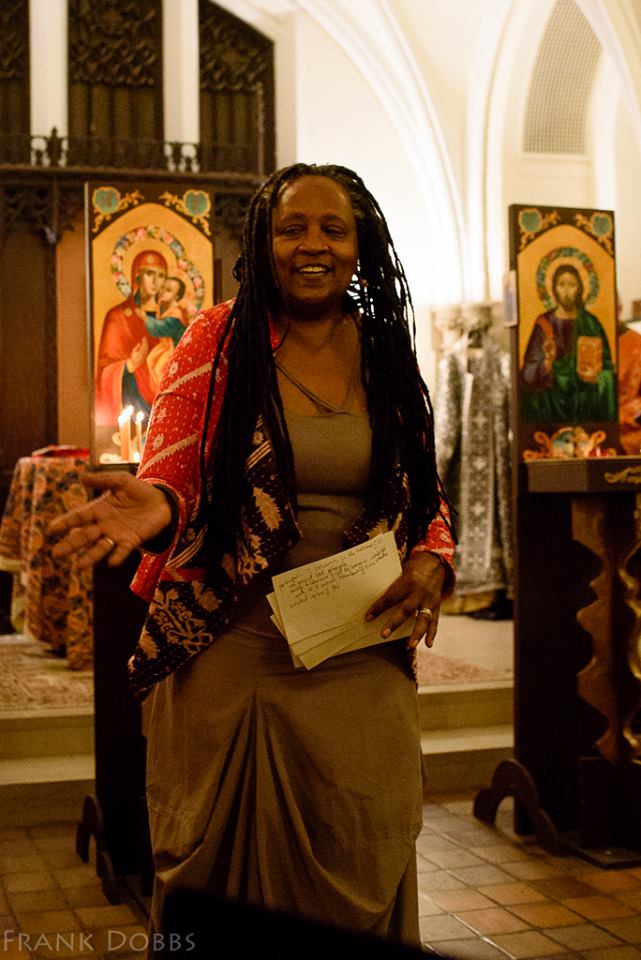
Our advisor Judith Scott shared with us a sermon she gave at her parish on the way we look forward to the events of the Crucifixion (and therefore the Resurrection) even as we await the good news of the Nativity:
Let us consider chronos (Eastern Standard Time for example) and kairos (sacred time), because we are preparing for the Nativity, God’s Incarnation, kairos bursting into chronos. We do this knowing that the future of the child who is born will suffer death and be buried. In our perception of time, this has already happened. Jesus conquers death for all of us, which is happening now and will be forever.
There are two ways of experiencing the dramatic way Orthodoxy plays with time when considering Jesus’s life, death and resurrection. And we deepen our understanding of the Jesus story as we contemplate this time shifting, time collapsing and expanding as we practice special prayers, fasting, and almsgiving during our preparations.
The first time shift is “simultaneity”: how the Crucifixion is foretold, how it is apprehended at the Nativity.
The second shift is an associative way of telling the Jesus story, such that each event as it happens in Jesus’s life is essentially reflected in later events. Called the Winter Pascha by Fr. Alexander Schmeman, the Church Nativity season parallels the season of Jesus’s death and resurrection in its theology, liturgy, hymns, and icons. As Fr. Thomas Hopko writes in The Winter Pascha (SVS Press, 1984, p11): “Jesus lay as an infant in the cavern in the reign of Caesar Augustus that he may lay in the tomb under Pontus Pilate. He was hounded by Herod that he might be caught by Caiaphas. He was buried in baptism that he might descend into death through the Cross. He was worshipped by wise men that the whole of creation might adore Him in His triumph over death. The Pascha of His Cross was prepared by the Pascha of His Incarnation. The Pascha of His Glorification was foretold by the Pascha of his Baptism.”
The iconography we study today teaches this in a way that is richly symbolic and visually expressive.
This is the Passionate Icon of the Mother of God from Palekh, Russia, which dates from around 1800. It continues the tradition of earlier Greek icons: Mary holds her son, Jesus, in her arms, her head tilted towards him, eyes gazing at us. She clasps his hand. Two angels hover above this central image. Jesus gazes up at the angel on his left (our right), who holds a cross, which will be the instrument of his death. Across from this angel is another one carrying the instruments of the Crucifixion: the spear that will pierce his side and a lance topped by a sponge. So Jesus’s death is foreseen even in his infancy. We see–and he knows–that his mission is to destroy death for all time by his death on the cross.


On this icon is written “Jesus Blessed Silence.” It depicts Jesus as an angel with wings and a red face denoting holy fire. The presumption of Blessed Silence is implied in three ways.
First, instead of a halo over Jesus’s head, we see an eight-pointed star, a “slava,” representing Creation (the eighth day being the New Age which is to come. Creation, of course, began in silence. Jesus, as Logos, was at the Creation and will be present at the end of days.
Second, this is an icon of the Nativity, denoted in the scroll Jesus holds. It says, “You are the God of Peace, Father of Mercies, the Angel of Great Counsel,” a line which comes from a hymn in the Nativity Liturgy. The Scriptural reference for silence at the Nativity comes from Isaiah 30:15: “For thus said the Lord God, the Holy One of Israel: In returning and rest you shall be saved; in quietness and in trust shall be your strength.” (So when we sing of “Silent Night, Holy Night,” we’re singing about the peace of the Gospel narrative of the Holy birth.)
Jesus’s Passion is a third symbol of Blessed Silence. It comes from Isaiah 53:7, the Suffering Servant text: “He was oppressed, and he was afflicted, yet he did not open his mouth; like a lamb that is led to the slaughter, and like a sheep that before its shearers is silent,so he did not open his mouth.”
Here, in one icon, Jesus Blessed Silence rests the Creation, Nativity, and Pascha.
This hymn sung on Good Friday brings us Jesus as present at the Creation, born at the Incarnation, and dying for us at the Crucifixion. We see all of his life witnessed at the time of his death, each image vivid, collapsing one into another, like a montage in film, superimposing one life event into another.
Today He who hung the earth upon the waters is hung on a tree.
Today He who holds the whole creation in His hand
Is born of a virgin.
The King of the angels is decked with a crown of thorns.
He whose essence none can touch is bound in swaddling clothes as a mortal human
He who wraps the heavens in clouds is wrapped in the purple of mockery.
God who in the beginning fashioned the heavens lies in a manger
He who freed Adam in the Jordan is slapped in the face.
He who rained manna on His people in the wilderness
Is fed on milk from his mother’s breast.
The Bridegroom of the Church is affixed to the cross with nails.
The Son of the Virgin is pierced by a spear.
We worship Your Passion, O Christ!
We worship Your Nativity, O Christ!
Show us also Your glorious Resurrection!
Show us also Your glorious Theophany!
May your Advent/Nativity fast season have been filled with heavenly light. May you find peace and joy in prayer and spiritual preparation for the birth of Our Lord.
Judith Scott is Axia's spiritual advisor.



